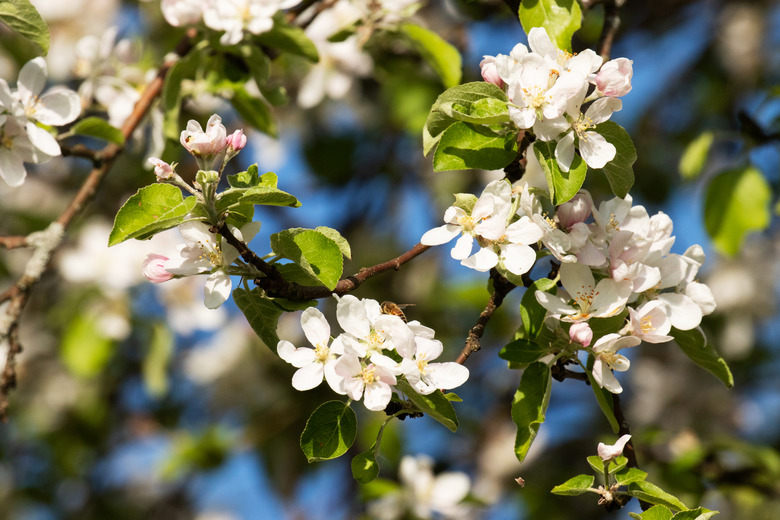Apple Trees With Yellow Leaves
In spring when your apple tree (Malus domestica) flushes with those fragrant flowers and then sets its tiny fruits, the season lies in front of you like a road to heaven as you anticipate your plentiful fall harvest. But between spring and fall, a lot can happen in the garden, and not all of it is good. If the leaves are turning yellow on your apple tree, it may be no cause for concern, or it could be a problem with nutrients, water, or disease.
Seasonal or Natural Leaf Yellowing
Seasonal or Natural Leaf Yellowing
Apple trees naturally drop some leaves throughout the growing season starting in summer and then increasing in fall as they prepare for winter. In summer when the weather is particularly hot and dry, apple trees may drop some leaves to conserve water.
This usually occurs with the first leaves to have developed in spring; they'll turn yellow and then drop off along with some of the small developing fruits. This is a normal occurrence and no cause for concern unless the tree's leaves are all turning yellow, and the tree is defoliating. In the fall, apple trees lose their leaves, first turning yellow and then sometimes brown before they fall off.
Lack of Important Nutrients
Lack of Important Nutrients
Some woody plants and trees can experience chlorosis, which is a result of the lack of certain micronutrients, usually iron or manganese. In an apple tree, leaves will turn yellow, although their veins will remain green. If untreated or severe, the leaves may then turn brown and die.
Chlorosis can be treated, but you need to determine its cause. Gather a sample of soil from the base of the tree, have it tested for micronutrients and pH, and then fertilize specifically for the missing nutrients.
Disease Causing Yellowing Leaves
Disease Causing Yellowing Leaves
Some apple tree varieties are susceptible to disease that can result in yellowing leaves. Golden Delicious apples in particular can develop necrotic leaf blotch, in which the leaves first display brown spots and then turn yellow. Eventually, the tree may lose all its leaves. If you have a Honeycrisp variety, it can develop Honeycrisp leaf mottling, in which the leaves turn a blotchy yellow in the summer. Unlike chlorosis, the yellowing is random and does not impact all the leaves. It is generally most visible on a leaf's edges. This is a genetic disorder specific to Honeycrisp.
Scab is another disease that can result in yellow apple tree leaves. First, the leaves will display olive-green spots, and then by midsummer, they will turn yellow if the infection is severe and will fall off.
Too Much or Too Little Water
Too Much or Too Little Water
Both too little water and too much water can result in the leaves turning yellow on an apple tree. Drought stress can cause leaves to wilt, turn yellow, and then fall, along with premature dropping of immature fruits. This most often occurs when very hot weather coincides with very dry weather, which can also result in the leaves looking burned and turning brown.
Too much water, on the other hand, can be just as damaging. If the soil becomes waterlogged and the roots are continually wet, the roots will stop growing and will not be able to absorb minerals. This will result in leaves turning yellow, usually first evident in the leaves in the bottom branches and on the inside of the crown, then moving up and out. In this case, your tree may experience root damage and root rot diseases that are fatal, killing off the tree in one or two years.
